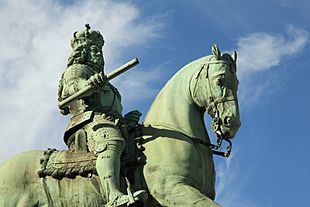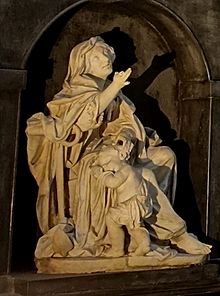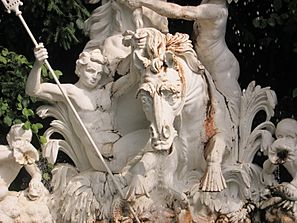Gabriël Grupello facts for kids
Quick facts for kids
Gabriël Grupello
|
|
|---|---|
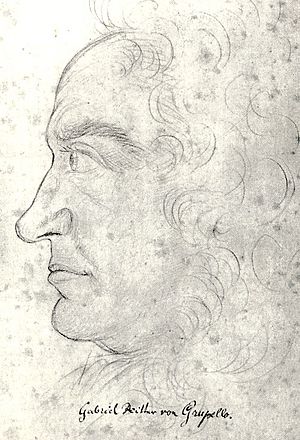
Self-portrait, c. 1700
|
|
| Born | 22 May 1644 |
| Died | 20 June 1730 (aged 86) |
| Occupation | sculptor |
Gabriël Grupello (born May 22, 1644 – died June 20, 1730) was a famous Flemish Baroque sculptor. He created many different kinds of sculptures, including religious art, statues of mythical figures, portraits, and public artworks. He worked in several countries like Flanders, France, and Germany. Grupello was a very skilled artist and was supported by many important rulers in Europe.
Contents
Life and Career
Early Years and Learning to Sculpt
Gabriël Grupello was born in Geraardsbergen. His father was an Italian army captain, and his mother was Flemish. Sadly, his father died when Gabriël was young.
When he was 14, Grupello began training as a sculptor. He spent five years learning in the workshop of Artus Quellinus the Elder in Antwerp. Quellinus was a leading Baroque sculptor. He had studied in Italy and brought new ideas about sculpting back to Antwerp. He believed sculptors should create large, complete artworks, not just decorations.
Quellinus worked on the new city hall in Amsterdam for 15 years. This building, now called the Royal Palace, became famous for its marble decorations. Many sculptors from Antwerp helped Quellinus with this huge project. Grupello might have helped too, though his exact contributions are not known. This project made Quellinus and his workshop well-known internationally. It also helped spread the Flemish Baroque style across Europe.
After Antwerp, Grupello studied for two more years in Paris and Versailles. There, he learned how to cast sculptures in bronze. He then worked for two years with another sculptor, Johan Larson, in The Hague.
Working in Brussels
In 1671, Grupello returned to Flanders. Two years later, he became a master of the Brussels Guild. This meant he was a recognized expert in his craft. He opened his own workshop in Brussels, which became very successful. He had many assistants working for him.
Grupello received support from the city of Brussels. He also had important clients like King Charles II of Spain, William II of Orange, and Frederick III, the Elector of Brandenburg.
From 1673 to 1678, Grupello worked on a special project. This was for the funerary chapel of Duke Lamoral of Thorn and Taxis in the Our Blessed Lady of Zavel Church in Brussels. Grupello created two statues for this chapel. These were allegorical figures, meaning they represented ideas. His statues were Hope (Spes) and Faith (Fides). They were placed in niches alongside other statues representing Charity and Truth.
The statue of Hope shows a sitting woman. She holds an anchor, which is a symbol of hope. There is also a child, which might represent the next generation. This could symbolize the Duke's son, who would continue the family name.
Moving to Germany
In 1695, Elector Johann Wilhelm appointed Grupello as his official court sculptor. This meant Grupello moved to Düsseldorf to work for the Elector. He made many sculptures of the royal couple using marble and bronze. He also oversaw other craftspeople working on the Elector's palaces. Grupello even designed a special fountain called the Grupello pyramid.
In 1698, Grupello married Anna Maria Dautzenberg. She was the daughter of the Elector's lawyer. They had five children together. In 1708, the Elector gave Grupello a house in the city center. This house is still called the Grupello-Haus or "Grupello House." Grupello rebuilt parts of the house and used it as his family home and a studio. Two bronze statues, thought to be by Grupello, were originally above the house's entrance. They are now in a local museum.
When Elector Johann Wilhelm died in 1716, Grupello's work at the court ended. The new Elector, Carl Philipp, cut costs and let go of many officials and artists. Grupello stayed in Düsseldorf. In 1719, Holy Roman Emperor Charles VI named him Imperial sculptor.
In 1725, Grupello and his wife moved to Ehrenstein Castle in Kerkrade. They lived with their daughter, who was married to an imperial official. Gabriël Grupello died there in 1730, at 86 years old.
Grupello's Artworks
Grupello was a very flexible artist. He created many different types of sculptures. He also worked with various materials like marble, ivory, and wood. He was one of the few Flemish Baroque sculptors of his time who also made bronze statues. A great example is his bronze equestrian statue of Elector Johann Wilhelm.
His early works show a classicist style. This might be because he studied in France. When he was in Brussels, his work was influenced by the Flemish Baroque style, especially by Peter Paul Rubens. His art then developed into a full Baroque style. A major work from his time in Brussels is a marble wall fountain. It was made for the main ballroom of the wholesale fishmongers guild.
Grupello brought this Baroque style with him when he moved to Düsseldorf. Later in his life, he focused more on religious art. He created crucifixes, Madonnas (statues of Mary), and statues of saints.
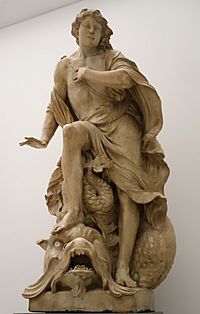
See also
 In Spanish: Gabriel de Grupello para niños
In Spanish: Gabriel de Grupello para niños


